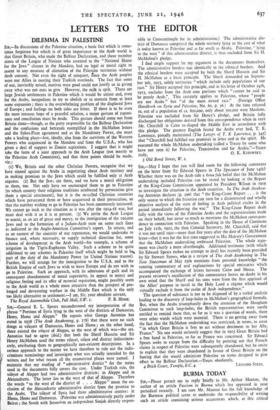Stn,—General E. L. Spears misunderstood my interpretation of the phrase
" Portions of Syria lying to the west of the districts of Damascus, Horns, Hama and Aleppo." He repeats what George Antonius has stated in 1938 (The Arab Awakening, p. 178) that there were no such things as vilayets of Damascus, Horns and Hama ; on the other hand, there existed the vilayet of Aleppo, to the west of which was—the sea. Antonius had to agree (ibid.) that both the Sherif Hussein and Sir Henry McMahon used the terms vilayet, vilaya and district indiscrimin- ately, attributing them to geographically non-existent descriptions. In a serious approach to the matter we have therefore to rule out the indis- criminate terminology and investigate what was actually intended by the writers and for what reason all the enumerated places were named. I maintain that my reading of "administrative district" for the terms used in the documents fully covers the case. Under Turkish rule, the vilayer of Aleppo had two administrative districts: in Aleppo and in Alexandretra. The latter lies to the west of that of Aleppo. Therefore the words " to the west of the district of . . . Aleppo" mean the ex- clusion of the Alexandretta administrative district from the promise to the Arabs. The vilayet of Syria had three administrative centres: in Hama, Horns and Damascus. (Palestine was administratively partly under Beirut ; the South with Jerusalem an independent Sanjak directly respon-
sible to Constantinople for its administration.) The administrative dis- trict of Damascus comprised the whole territory lying to the east of what is today known as Palestine and as far south as Akaba. Palestine, " lying to the west" of this administrative district, is thus excluded from Sir H. McMahon's pledge.
I find ample support for my argument in the documents themselves. The administrative borders run identically to the ethnical borders. And the ethnical borders were accepted by both the Sherif Hussein and Sir H. McMahon as a basic principle. The Sherif demanded on Septem- ber 9th, 1915, solely territories " which include only populations of our race." Sir Henry accepted this principle, and in his letter of October 24th, 1915, excludes from the Arab area portions which " cannot be said to be purely Arab.", This certainly applies to Palestine, whose " people are not Arabs " but " of the most mixed race." (Foreign Office Handbook on Syria and Palestine, No. 6o, p. 56.) At the time referred to, out of a population of ca. 800,000, only about soo,000 were Moslems. Palestine was excluded from Sir Henry's pledge, and Britain fully discharged her obligations derived from this correspondence when in 1921 Mr. Churchill in Cairo re-shaped the Middle East in accordance with this pledge. The greatest English friend the Arabs ever had, T. E. Lawrence, proudly maintained (The Letters of T. E. Lawrence, p. 345) that "Churchill had fulfilled our promises in letter and in the spirit. He executed the whole McMahon undertaking (called a Treaty by some who have not seen it) for Palestine, Transjordan and for Arabia."—Yours 3 Old Bond Street, W. r.


























 Previous page
Previous page